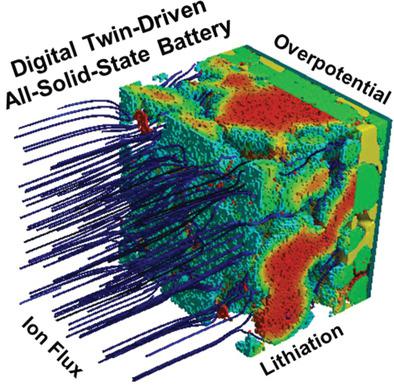当前位置:
X-MOL 学术
›
Adv. Energy Mater.
›
论文详情
Our official English website, www.x-mol.net, welcomes your
feedback! (Note: you will need to create a separate account there.)
Digital Twin‐Driven All‐Solid‐State Battery: Unraveling the Physical and Electrochemical Behaviors
Advanced Energy Materials ( IF 24.4 ) Pub Date : 2020-07-26 , DOI: 10.1002/aenm.202001563 Joonam Park 1 , Kyu Tae Kim 2, 3 , Dae Yang Oh 2, 3 , Dahee Jin 1 , Dohwan Kim 1 , Yoon Seok Jung 2, 3 , Yong Min Lee 1
Advanced Energy Materials ( IF 24.4 ) Pub Date : 2020-07-26 , DOI: 10.1002/aenm.202001563 Joonam Park 1 , Kyu Tae Kim 2, 3 , Dae Yang Oh 2, 3 , Dahee Jin 1 , Dohwan Kim 1 , Yoon Seok Jung 2, 3 , Yong Min Lee 1
Affiliation

|
The digital twin technique has been broadly utilized to efficiently and effectively predict the performance and problems associated with real objects via a virtual replica. However, the digitalization of twin electrochemical systems has not been achieved thus far, owing to the large amount of required calculations of numerous and complex differential equations in multiple dimensions. Nevertheless, with the help of continuous progress in hardware and software technologies, the fabrication of a digital twin‐driven electrochemical system and its effective utilization have become a possibility. Herein, a digital twin‐driven all‐solid‐state battery with a solid sulfide electrolyte is built based on a voxel‐based microstructure. Its validity is verified using experimental data, such as effective electronic/ionic conductivities and electrochemical performance, for LiNi0.70Co0.15Mn0.15O2 composite electrodes employing Li6PS5Cl. The fundamental performance of the all‐solid‐state battery is scrutinized by analyzing simulated physical and electrochemical behaviors in terms of mass transport and interfacial electrochemical reaction kinetics. The digital twin model herein reveals valuable but experimentally inaccessible time‐ and space‐resolved information including dead particles, specific contact area, and charge distribution in the 3D domain. Thus, this new computational model is bound to rapidly improve the all‐solid‐state battery technology by saving the research resources and providing valuable insights.
中文翻译:

数字双驱动全固态电池:揭示物理和电化学行为
数字孪生技术已广泛用于通过虚拟副本有效地预测与实际对象相关的性能和问题。但是,由于需要大量的多维多维复数方程的计算,因此至今尚未实现双电化学系统的数字化。然而,随着硬件和软件技术的不断进步,数字双驱动电化学系统的制造及其有效利用已成为可能。在此,基于体素的微结构构建了具有固态硫化物电解质的数字双驱动全固态电池。使用实验数据验证了其有效性,使用Li 6 PS 5 Cl的0.70 Co 0.15 Mn 0.15 O 2复合电极。通过从质量传输和界面电化学反应动力学方面分析模拟的物理和电化学行为,来检查全固态电池的基本性能。本文的数字孪生模型揭示了有价值的但实验上无法获得的时间和空间分辨信息,包括死粒子,比接触面积和3D域中的电荷分布。因此,这种新的计算模型势必通过节省研究资源并提供宝贵的见识来迅速改善全固态电池技术。
更新日期:2020-09-15
中文翻译:

数字双驱动全固态电池:揭示物理和电化学行为
数字孪生技术已广泛用于通过虚拟副本有效地预测与实际对象相关的性能和问题。但是,由于需要大量的多维多维复数方程的计算,因此至今尚未实现双电化学系统的数字化。然而,随着硬件和软件技术的不断进步,数字双驱动电化学系统的制造及其有效利用已成为可能。在此,基于体素的微结构构建了具有固态硫化物电解质的数字双驱动全固态电池。使用实验数据验证了其有效性,使用Li 6 PS 5 Cl的0.70 Co 0.15 Mn 0.15 O 2复合电极。通过从质量传输和界面电化学反应动力学方面分析模拟的物理和电化学行为,来检查全固态电池的基本性能。本文的数字孪生模型揭示了有价值的但实验上无法获得的时间和空间分辨信息,包括死粒子,比接触面积和3D域中的电荷分布。因此,这种新的计算模型势必通过节省研究资源并提供宝贵的见识来迅速改善全固态电池技术。











































 京公网安备 11010802027423号
京公网安备 11010802027423号